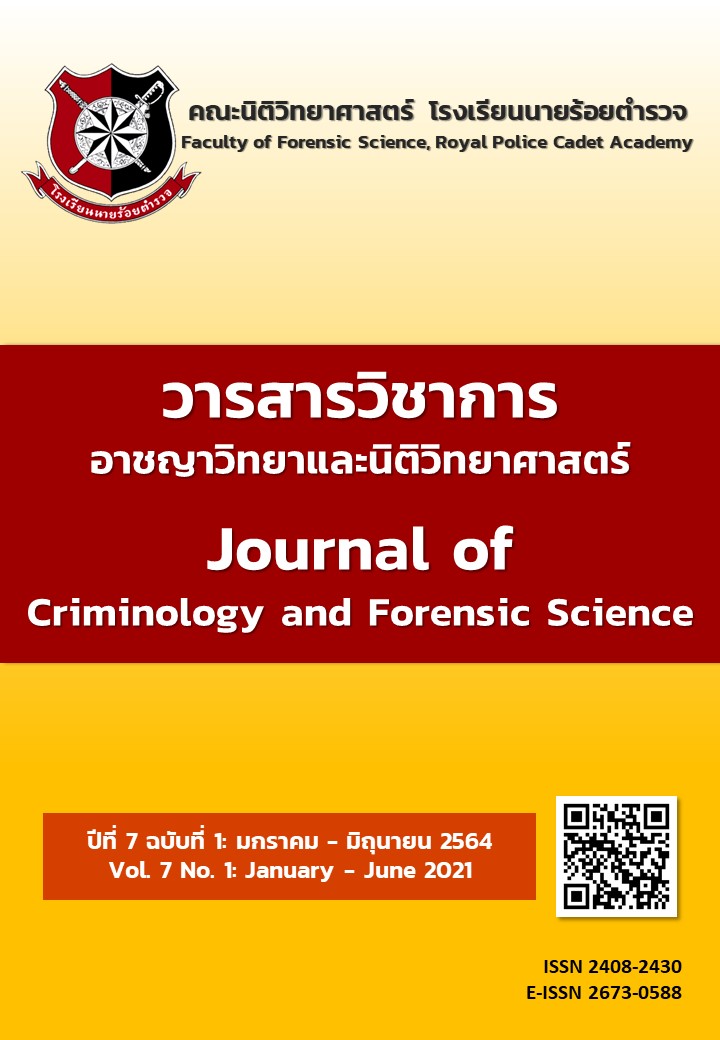The Effect of Different Acetone Grade on Quality of Latent Fingerprint Developed Using Ninhydrin Technique
Main Article Content
Abstract
The purpose of this research is to compare the quality of latent fingerprints developed by Ninhydrin technique in 5 different grades of acetone namely ACS Grade (standard Grade), AR Grade, Laboratory Grade, Purified Grade and Commercial Grade on 2 porous surfaces. Also, this study aims to compare the duration of the persistence of fingerprints that appear after the test with the Ninhydrin technique in different acetone grades. This research is an experimental research using 2 types of analysis: statistical analysis and quality degree analysis. The findings reveal that the quality of the fingerprint can be detected with no statistically significant (p = .05) under the use of different grades of acetone on the samples of notebook and A4 paper. In addition, the quality of latent fingerprints taken from the volunteers using standard grade acetone (ACS Grade) compared with commercial Grade is not statistically significant different. This study, therefore, concludes that the quality of latent fingerprints detected using the different grades of acetone is not varied.
Article Details
เนื้อหาและข้อมูลในบทความที่ลงตีพิมพ์ใน วารสารวิชาการอาชญาวิทยาและนิติวิทยาศาสตร์ โรงเรียนนายร้อยตำรวจ ถิอว่าเป็นข้อคิดเห็นและความรั้บผิดชอบของผู้เขียนบทความโดยตรงซึ่งกองบรรณาธิการวารสาร ไม่จำเป็นต้องเห็นด้วยหรือรับผิดชอบใดๆ
บทความ ข้อมูล เนื้อหา รูปภาพ ฯลฯ ที่ได้รับการตีพิมพ์ใน วารสารวิชาการอาชญาวิทยาและนิติวิทยาศาสตร์ ถือว่าเป็นลิขสิทธิ์ของวารสาร วารสารวิชาการอาชญาวิทยาและนิติวิทยาศาสตร์ หากบุคคลหรือหน่วยงานใดต้องการนำทั้งหมดหรือส่วนหนึ่งส่วนใดไปเผยแพร่ต่อหรือเพื่อกระทำการใดๆ จะต้องได้รับอนุญาตเป็นลายลักษณ์อักษรจาก วารสารวิชาการอาชญาวิทยาและนิติวิทยาศาสตร์ ก่อนเท่านั้น
References
Almog, J. (2001). Fingerprint Development by Ninhydrin and Its Analogues. In H. C. Lee, and R. E. Gaensslen (Ed.). Advances in Fingerprint Technology (2nd Edition, 177-210). Boca Raton: CRC Press.
Berry, J., and Stoney, D. A. (2001). History and Development of Finger-printing. In H. C. Lee, and R. E. Gaensslen (Ed.). Advances in Fingerprint Technology (2nd Edition, 1-40). Boca Raton: CRC Press.
Chacko, L. W., and Vaidya, M. C. (1968). The Dermal Papillae and Ridge Patterns in Human Volar Skin. ACTA Anatomica (Basel). 70(1), 99–108.
Chamsuwanwong, A. (2009). Forensic Science 2 for Investigation. 6th Edition. Bangkok: T.C.G.Printing. (In Thai)
Cole, S. A. (2002). Suspect Identities: A History of Fingerprinting and Criminal Identification. 2nd Edition. The United States of America: Harvard University Press.
De Forest, H. P. (1938). The First Finger-Print File in the United States. Finger Print Magazine, 19, 16–20.
International Association for Identification. (n.d.). IAI History. Retrieved January 6, 2019. from https://theiai.org/iai_history.php.
McCaldin, D. J. (1960). The Chemistry of Ninhydrin. Chemical Reviews, 60(1), 39–51.
Moore, R. T. (1991). Automatic Fingerprint Identification Systems. In H. C. Lee, and R. E. Gaensslen (Ed.). Advances in Fingerprint Technology (1st Edition, 163-191). New York: Elsevier.
National Institute of Standards and Technology. (1993). American National Standards for Information Systems Data Format for the Interchange of Fingerprint Information. Washington, D.C.: U.S. Government Printing Office.
Network of Forensic Science Institutes. (2016). Best Practice Manual for Fingerprint Examination. Retrieved January 6, 2019. from https://enfsi.eu/wp-content/uploads/2 016/09/6._fingerprint_examination_0.pdf.
Okajima, M. (1975). Development of Dermal Ridges in the Fetus. Journal of Medical Genetics, 12(3), 243–250.
Petruncio, A. V. (2000). A Comparative Study for the Evaluation of Two Solvents for Use in Ninhydrin Processing of Latent Print Evidence. Journal of Forensic Identification, 50(5), 462-469.
Rovee, D. T., and Maibach, H. I. (2004). The Epidermis in Wound Healing. New York: CRC Press.
Royal Thai Police. (2017). Interesting Criminal Arrest Statistics. Retrieved February 2, 2019. from http://statbbi.nso.go.th/staticreport/page/sector/th/09.aspx.
Semathong, W. (2012). Developing of Latent Fingerprint from Blood on Various Types of Paper using Ninhydrin Techniques. Master of Science Thesis. Silpakorn University, Nakhon Pathom. (In Thai).
Songnonlek, N. (2012). Development of latent fingerprint on non – porous surface by using turmeric powder. Master of Science Thesis. Silpakorn University, Nakhon Pathom. (In Thai).
Srihari, S. N., Srinivasan, H., and Fang, G. (2008). Discriminability of Fingerprints of Twins. Journal of Forensic Identification, 58(1), 109–127.
Sripakdee, T. (2014). Acetone. Retrieved February 8, 2019. from https://www.siamchemi.com/acetone/.
Stock, R. M. (1987). An Historical Overview of Automated Fingerprint Identification Systems. Laboratory Division, Federal Bureau of Investigation, U.S. Department of Justice, 51–60.
Suttatham, P. (2008). Developing Latent Fingerprints on Various Types of Papers by using 1,2-Indanedione. Master of Science Thesis. Silpakorn University, Nakhon Pathom. (In Thai).
Tanjinda, N. (2013). Fingerprint Detection on Thermal Paper using Iodine Fuming, Ninhydrin and 1, 2 Indanedione Methods. Master of Science Thesis. Silpakorn University, Nakhon Pathom. (In Thai).
U.S. Department of Justice. (2014). The Fingerprint Sourcebook. Retrieved January 6, 2019. from https://www.ojp.gov/pdffiles1/nij/225320.
Yemm, E. W., Cocking, E. C., and Ricketts, R. E. (1955). The Determination of Amino-Acids with Ninhydrin. Analyst, 80, 209–214.


